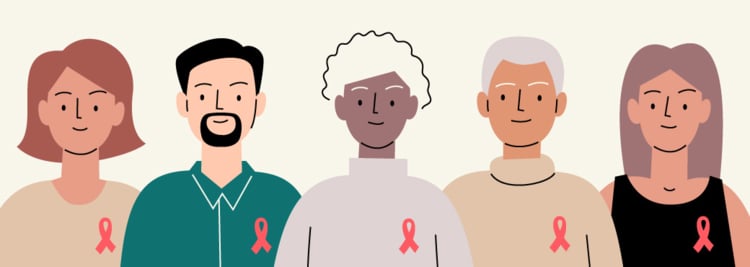The most frequently asked question for HIV-positive patients is “how long can you live with HIV?” Fortunately, the answer is far more promising than it was 20 years ago. Join Flo as we discuss how advancements in medical technology have altered the prognosis for those living with HIV or AIDS.
-
Tracking cycle
-
Getting pregnant
-
Pregnancy
-
Help Center
-
Flo for Partners
-
Anonymous Mode
-
Flo app reviews
-
Flo Premium New
-
Secret Chats New
-
Symptom Checker New
-
Your cycle
-
Health 360°
-
Getting pregnant
-
Pregnancy
-
Being a mom
-
LGBTQ+
-
Quizzes
-
Ovulation calculator
-
hCG calculator
-
Pregnancy test calculator
-
Menstrual cycle calculator
-
Period calculator
-
Implantation calculator
-
Pregnancy weeks to months calculator
-
Pregnancy due date calculator
-
IVF and FET due date calculator
-
Due date calculator by ultrasound
-
Medical Affairs
-
Science & Research
-
Pass It On Project New
-
Privacy Portal
-
Press Center
-
Flo Accuracy
-
Careers
-
Contact Us
HIV Life Expectancy: How Long Can You Live with HIV or AIDS?


Every piece of content at Flo Health adheres to the highest editorial standards for language, style, and medical accuracy. To learn what we do to deliver the best health and lifestyle insights to you, check out our content review principles.
A national database containing statistics from 25 states shows that the average HIV life expectancy has more than doubled between 1996 and 2005. The bump from 10.5 to 22.5 years after diagnosis can be attributed to vast improvements in drug therapy and related approaches. However, experts still say this is only an average, and plenty of other circumstances must be taken into account regarding HIV life expectancy.
Calculating life expectancy with HIV or AIDs
Recent research shows that a young person with HIV or AIDS could potentially live almost as long as anyone else in the general population. But this is only the case if they have routine access to health care and respond well to modern antiretroviral treatments (ARTs). So a 20-year-old who starts on ARTs today, for example, might eventually live to be 67.
Keep in mind though, since there is no known cure, HIV life expectancy varies greatly from one individual to the next based on many things. This includes early detection; plus, gender and lifestyle choices such as alcohol, tobacco, or drug use.
Over the past two decades, HIV life expectancy has drastically risen. What was once considered a terminal illness is now a medically manageable condition at any age. Those who abuse intravenous (IV) drugs or possess a preexisting immune disorder, however, do not fare as well.
In light of huge disparities in access to health care and ARTs, the CDC regularly publishes reports on obstacles to HIV and AIDS treatment. By 2016, it was estimated that 1.1 million people in the U.S., aged 13 or older, had HIV (14 percent of whom were undiagnosed).
Additional CDC data points to the prevalence of HIV among individuals at or below federally established poverty levels. Even beneficiaries of disability payments for advanced HIV or AIDS are limited in their earning capacity due to income caps imposed by government programs. The same report further highlighted education level and employment status as contributing factors to HIV and AIDS vulnerability.
AIDS or HIV life expectancy without medication
How long can you live with HIV or AIDS if you chose not to treat with ART combinations or other prescription drugs? In the absence of such therapy, a patient should expect to see a notable decrease in life expectancy.
In countries where health care and ARTs aren’t readily accessible, HIV rates (in individuals aged 15 to 49) are above 20 percent. Shorter HIV life expectancy in these regions, combined with a high incidence of AIDS in younger age groups, boosts their overall mortality rate.
Population studies proved that AIDS patients who did not take HIV medications survived for roughly three years. Once they developed a dangerous opportunistic illness, life expectancy with AIDS (in the absence of treatment) decreased to one year or less.
That’s why HIV and AIDS remain a serious threat to public health, and why early detection is absolutely critical to long-term survival.
6 habits to improve life expectancy with HIV or AIDs
Thanks to the continuing evolution of modern medicine, it’s still possible to lead a happy and fulfilling life with HIV or AIDS by:
1. Staying physically and mentally active

Socializing with friends, reading, listening to music, and engaging in your favorite hobbies helps battle depression and the loss of brain function. Don’t be afraid to try something different, which might offer a chance to forge new relationships and serve as a source of personal enjoyment.
2. Taking prescribed medications
Early intervention with ARTs goes a long way towards tackling the debilitating symptoms of HIV and AIDS. Beginning a treatment regimen is the first step in creating a positive care plan and should include strategies for protecting your immune system. Since numerous ART options exist to manage the virus, consult your health care provider about tailoring a drug plan to your unique symptoms.
Be sure to take drugs exactly as prescribed and keep all office appointments. Consistency is key, so this might mean administering meds at the same time every day. If you deviate from the care plan (e.g., skipping doses, taking doses at random times), it may compromise your immune response.
3. Eating a healthy, customized diet
While eating right is beneficial to everyone, it’s absolutely essential for HIV and AIDS patients, regardless of what stage they’re in. The drugs prescribed to combat the virus often upset the digestive system, causing additional issues, such as:
- Changes in metabolism
- Upset stomach, nausea, vomiting, or diarrhea
- Oral infection (or candidiasis)
- Cancer (or Kaposi sarcoma)
Any of the above conditions may prevent the body from absorbing vital nutrients, as well as ARTs. Remember to avoid foods that raise the chances of infection like uncooked meats and raw fish. Note that a well-tailored diet is capable of:
- Raising energy levels with essential vitamins and minerals
- Managing HIV symptoms and complications
- Maintaining a healthy weight
- Enhancing absorption of medications
- Decreasing drug-related side effects
Have an in-depth conversation about dietary needs with your health care provider. They’ll explain the proper steps to take and perhaps suggest seeing a dietitian or nutritionist for help with meal planning and assessment.
4. Adopting better food safety habits
Because HIV and AIDS compromise the immune system’s defenses, patients are more susceptible to foodborne illnesses. Stick to these basic rules for safeguarding your health:
- Avoid raw eggs, meats, fish, and other seafood.
- Use a separate cutting board for meat.
- Wash all fruits and vegetables thoroughly.
- Clean cutting boards, utensils, and your hands with warm soapy water after coming into contact with raw meat and other ingredients.
- Avoid drinking water or any products prepared with water from natural, unfiltered sources (e.g., lakes, ponds, rivers, etc.). Switch to bottled or filtered tap water at home.
- Boil water before drinking or cooking with it to kill waterborne bacteria.
- When traveling abroad, steer clear of local drinking water and ice, as well as unpasteurized beverages.
5. Exercising regularly
Exercise is a great way to maintain long-term physical and mental health, while also upping strength, endurance, and fitness. An HIV or AIDS diagnosis will not affect your ability to engage in these activities. Ask your health care provider about how to stay fit and make workouts a part of your daily routine.
6. Practicing safe sex
Just because you or your partner is HIV positive doesn’t mean you have to abstain from sex. The hormones released during sexual intercourse produce positive physical and mental effects that help keep you happy and healthy.
However, the number one rule to follow is to wear a condom every time you have sex! Scientific research establishes a clear link between condom usage and a reduced risk of HIV transmission. They also shield you from other sexually transmitted infections which might impact your ability to fight HIV or AIDS.


Hey, I'm Anique
I started using Flo app to track my period and ovulation because we wanted to have a baby.


The Flo app helped me learn about my body and spot ovulation signs during our conception journey.


I vividly
remember the day
that we switched
Flo into
Pregnancy Mode — it was
such a special
moment.
Real stories, real results
Learn how the Flo app became an amazing cheerleader for us on our conception journey.

